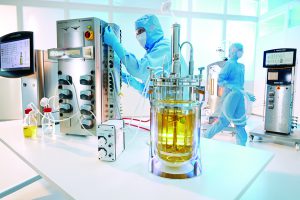 An international group of experts met last year and exchanged their latest findings in bioprocessing technology at the Sartorius Stedim Biotech Upstream and Downstream Technology Forum, held at Sartorius College in Göttingen, Germany. This conference continues a more than decade-long tradition of bringing together leaders in bioprocess development and biomanufacturing operations from the world’s leading biopharmaceutical companies to explain how they are addressing the most important industry challenges.
An international group of experts met last year and exchanged their latest findings in bioprocessing technology at the Sartorius Stedim Biotech Upstream and Downstream Technology Forum, held at Sartorius College in Göttingen, Germany. This conference continues a more than decade-long tradition of bringing together leaders in bioprocess development and biomanufacturing operations from the world’s leading biopharmaceutical companies to explain how they are addressing the most important industry challenges.
Although conference presentations were divided as related to either upstream processing, downstream processing, or where upstream meets downstream, the goal was to show that process optimization relies on the integration of all operations. Higher cell titers and the efficiency of upstream unit systems directly affect downstream processing and purification. Optimized biomanufacturing is needed to shorten timelines, reduce costs, and reach the clinic quickly and confidently.
Developing highly productive, efficient processes were popular topics at the forum. An increasing number of biomanufacturers are implementing quality by design (QbD) principles by incorporating risk management at every process step. By monitoring variability and linking critical process parameters to product quality, biomanufacturers can ensure high-quality products through robust production processes.
Key Topics in Upstream Processing
Automation is making rapid progress in upstream processing. Automated systems reduce variability because they decrease or eliminate the number of manual operations in a process step. They also reduce setup time compared with manual operations, thereby saving costs. Several presentations focused on how upstream processes can incorporate automated systems in their design.
High-throughput tools are a significant technology that the biopharmaceutical industry has adopted in recent years and received significant attention from the invited speakers who described how scientists could apply them during the rapid development of upstream processes. Biomanufacturers today are interested in flexible options for their upstream operations. Several presentations focused on the various platform options for upstream operations such as cell cultivation of high cell density cultures, including fed-batch, perfusion, and continuous processing as well as optimized or custom media for highly productive cell lines.
Single-use bioreactor systems continue to be of great interest, and forum presentations showed that “high levels of comparability” between single-use bioreactors and multiuse systems in novel applicatons. Other presenters described how upstream processes that have been developed can be scaled-up to allow robust commercial manufacturing in single-use bioreactors. Process analytical technologies and knowledge management tools are providing unprecedented amounts of information on our bioprocesses, leading to greater control over product quality.
 Key Topics in Downstream Processing
Key Topics in Downstream Processing
Downstream processing experts at the forum described the latest methods and techniques that the biopharmaceutical industry is applying for monoclonal antibody, viral vaccine, and antibody–drug conjugate purification. Presenters described how single-use technologies are being applied across entire purification processes. This is allowing companies to install additional manufacturing capacity more quickly and with lower capital expenditure.
Speakers also explained the latest processing techniques to ensure the viral safety of drug products. By adopting these approaches in downstream processing, the industry can develop higher performing and safer biological drugs for patients.
To share this information with a wider audience, we are pleased to invite you to read a summary of last year’s Upstream and Downstream Technology Forum.
